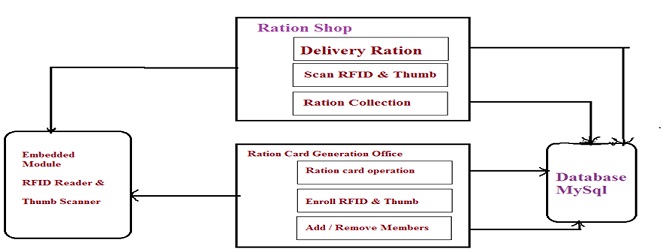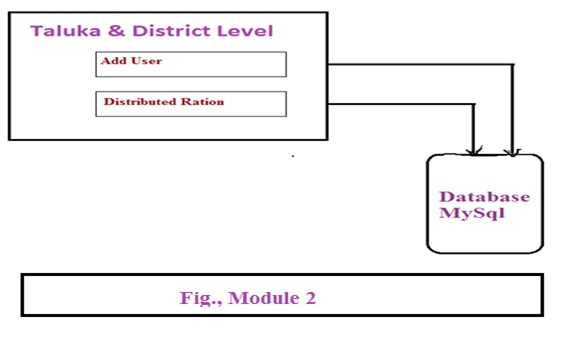





Published on Mar 01, 2025
India’s Public Distribution System (PDS) is the largest retail system in the world. System of Public Distribution provides a ration card issued under an order or authority of the State Government for the buy of essential consumer materials like rice, wheat, kerosene and oil. State Government issues distinctive ration identity cards like yellow ration card, saffron (orange) ration card, and white ration card depending on family annual income. The consumer material is feeding to ration card holders in the first week of every month by ration shop keeper.
System of Public Distribution is one of the widely disputable issues that involve malpractice. The manuscript intervention in weighing of the materials leads to incorrect measurements and/or it may happen, the ration shop owner illegally uses consumer materials (Rice, Wheat, Kerosen) without previously knowledge of ration card holders.
The proposed system aids to power control malpractices which are present in ration shop by superseding manual work with automatic system based on RFID. Every consumer i.e. family head provided RFID radio frequency identification card which acts as ration identity card. The RFID card has unique (rival) identification number. The consumer scans the card on RFID radio frequency identification reader which is faced with microcontroller kept at ration shop. Once consumer is validated by details, the system shows customer’s product and cost. Based on material chosen by consumer, appropriate correct circuitry will be activated and consumer gets material. The proposed RFID based automatic ration shop system would bring transparency appropriate in public distribution system and become aids helpful to prevent malpractices.
Radio frequency identification technology has shifted from opacity into mainstream applications that aid speed the handling of manufactured goods and crucial. In urban areas, kerosen ( fuel) is supplied to ration card holders in the first week (sennight) of every month and the ration shop keepers are taking keen steps to give or distribute kerosene (Fuel) to cardholders a minimum of three or four days a week. The Indian ration identity card is mainly used for purchasing , buying capitalized food and fuel for example fuel. It is an important subsistence medium for the poor people, supplying proof of identity and a connection with government databases. The present ration distribution method system has drawbacks like incorrect number quantity of goods, subordinate processing speed, Extensive waiting time, material larceny in ration shop.
The present ration distribution partition system has drawbacks like
Incorrect quantity of goods
Subordinate processing speed
Large waiting time
Material Larceny in ration shop. Proposed system replace manual work lin ration shop.
The proposed system replaces the manual work in ration shop. RFID means Radio Frequency Identification technique is used to prevent the ration forgery. Now a day this process is online which comes as mercy for the applicants who hate standing for apart time in queues for filling the application request form and then go to the office control again to know the status. In this each user will be having RFID based ration card which contain user information including Bank details. These cards having unique numbers. Whenever user want to buy some grocery he must show his RFID based ration card to shopkeeper. Each ration shop contain RFID reader which reads RFID ration card, RFID reader used to check user valid or not.
The biometrics will be used in this system. It works for an identification of user. It stores fingerprints of users to database. This new produced system will cover the human efforts and also the slicker is detected in that method system and the forgery is also as removed. Few motivational factors of proposed system are reduce forgery at ration shop and get grocery in easy way. Reduction in manual work.
System will be more transparent. No need to stand in queue for long time. Automatic generation of message after Bank transaction. Frauds get detected easily. Biometric is used in security, surety, guaranty and access control applications to mean mensurable physical characteristics of a correct person that can be practically examined on an automated basis.
Proposed system is to reduce forgery from ration shops and users will get their grocery in easy way. Also to reduce manual script work. In the proposed system we will develop the smart ration card system based on the RFID radio frequency identification and the BIOMETRICS, in which the user or family head or family member can fill their data online.
And also the manual script working is not there. When user wants, they desire a ration, he/she comes with the Smart ration card, then the RFID radio frequency identification card is swipe and check whether the user is valid or peaked. The fingerprints of that user also check audit and the allocated ration is distribute to that particular user, changes or alter of conquering and issuing of ration is done automatically in the govt. database.
In the proposed system the card will swap and then the RFID radio frequency identification will read the tag ad then for the valid correct user the finger prints will provided taken and then check for the valid or the peaked user. If user is not valid then exit or the user unable to take the ration and if valid then the list of attribute of grocery will show on screen and then the distributor will distribute presentation the grocery and then pay a money and then exit. Bank details are present on RFID, after swapping the card particular amount of grocery is deducted from account and message will be sent to user.
Using this proposed system we can avoid the corruption in rationing system to a large extent by providing transparency at each level. As there is no manual data stored in books or register, all the data is stored in database hence it is easy for higher authority to cross check the data at any point. So implementing this will be really helpful to targeted people. Reduce the corruption level and can mostly blight it from the above mentioned system which will aid the country's economy to reach new heights. The computerized PDS i.e System of Public Distribution is simple to implement and requires much minus hard work when compared to the other system.
Main objective of the system is to reduce forgery from ration shops and users will get their grocery in easy way. Also to reduce manual work. In the proposed system we will develop the smart ration card system based on the RFID and the BIOMETRICS, in which the user can fill their data online. And also the manual working is not there. Bank details are present on RFID, after swapping the card particular amount of grocery is deducted from account and message will be sent to user.


The proposed system is more secure, certain and transparent than the normal existing system. Influence of fraud falsity data entry intake in the ration database can be maintained simply with the use of this smart ration card system. Only authorized person (shop keeper, tradesman) can operate the database. Customer can be authenticated using RFID swapping and thumb detection. In the planned It is expected that the proposed system will be more transparent, reliable than the existing ration card system.
1) Mohit Agarwal, Manish Sharma, Bhupendra singh, Shantanu “Smart Ration Identity Card based on RFID radio frequency identification and GSM Technique”International Journal Paper 978-1-4799-4236-7/14/$31.00_c 2014 IEEE
2) Mandeep Kaur, Sandhu Manjeet, Mohan Neeraj and Parvinder, Sandhu S “RFID radio frequency identification Technology ” Journal International of Computer as well as Electrical Engineering, February, 2011, 1793-8163
3) Sana A. Qader Perampalli1, Dr. R.R. Dube2 “Smart Card based e-Public Distribution Partition System” International Journal of Advanced forward Research in Computer, Communication Engineering Vol. 5, Issue 5, May 2016